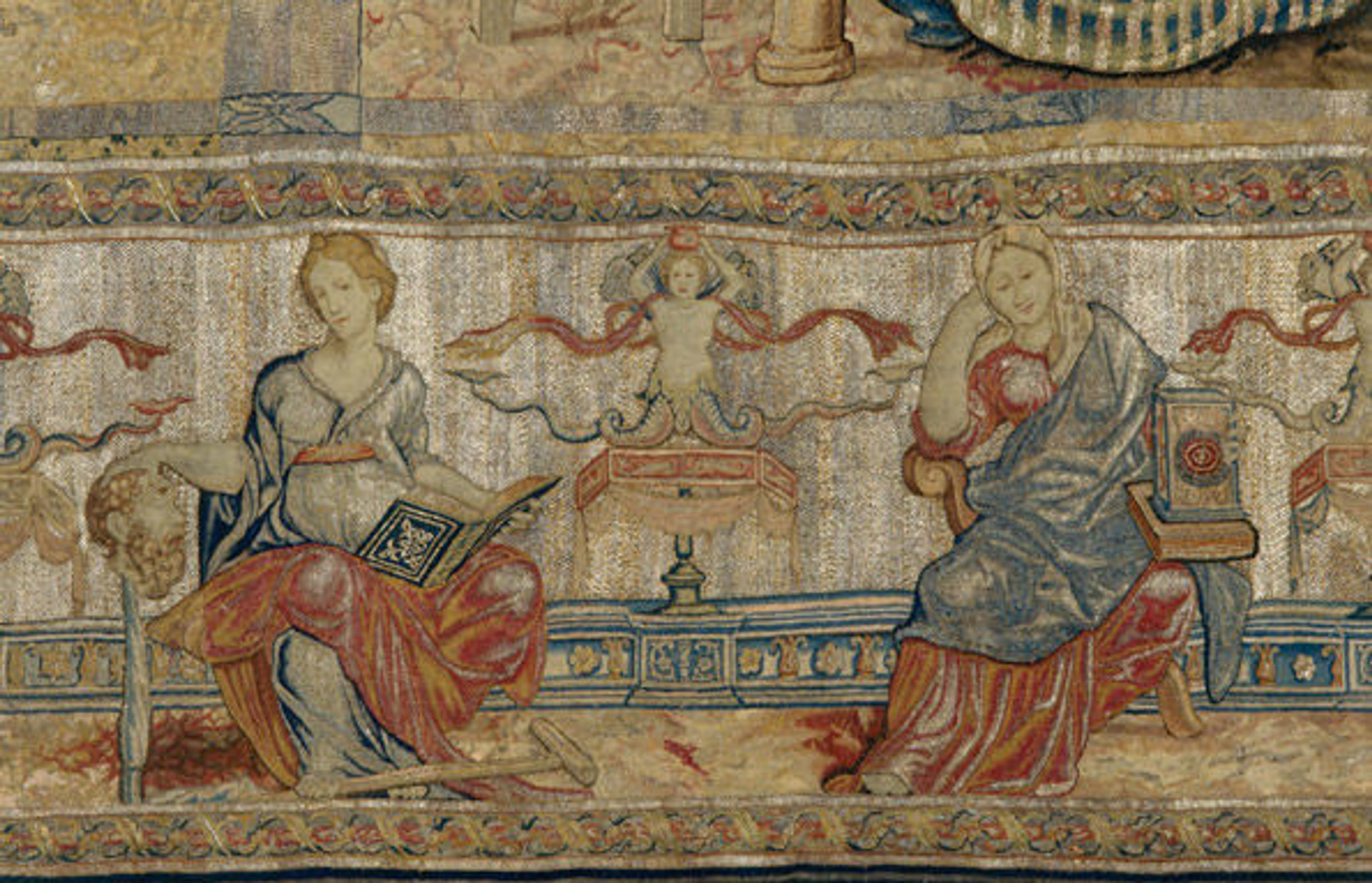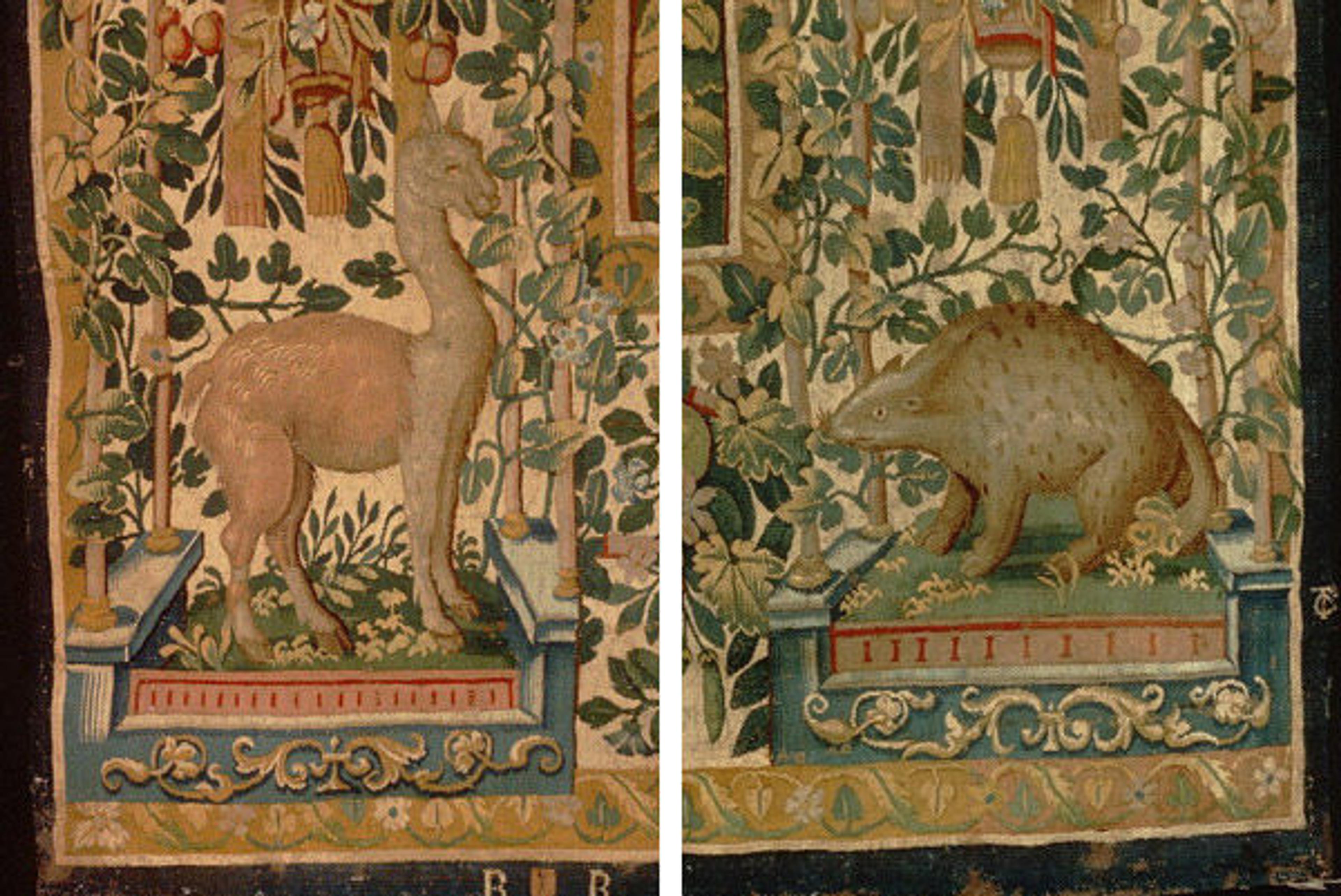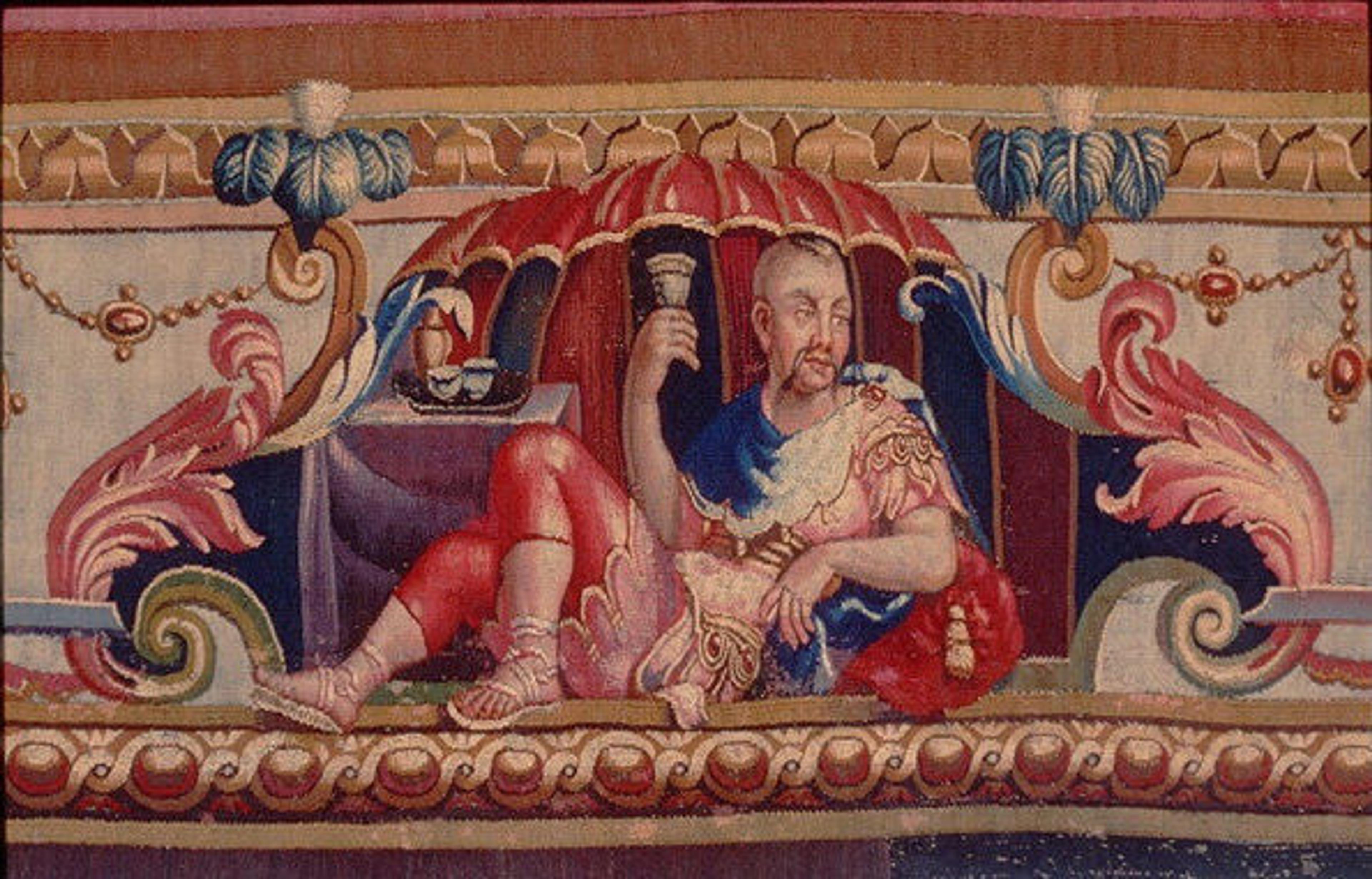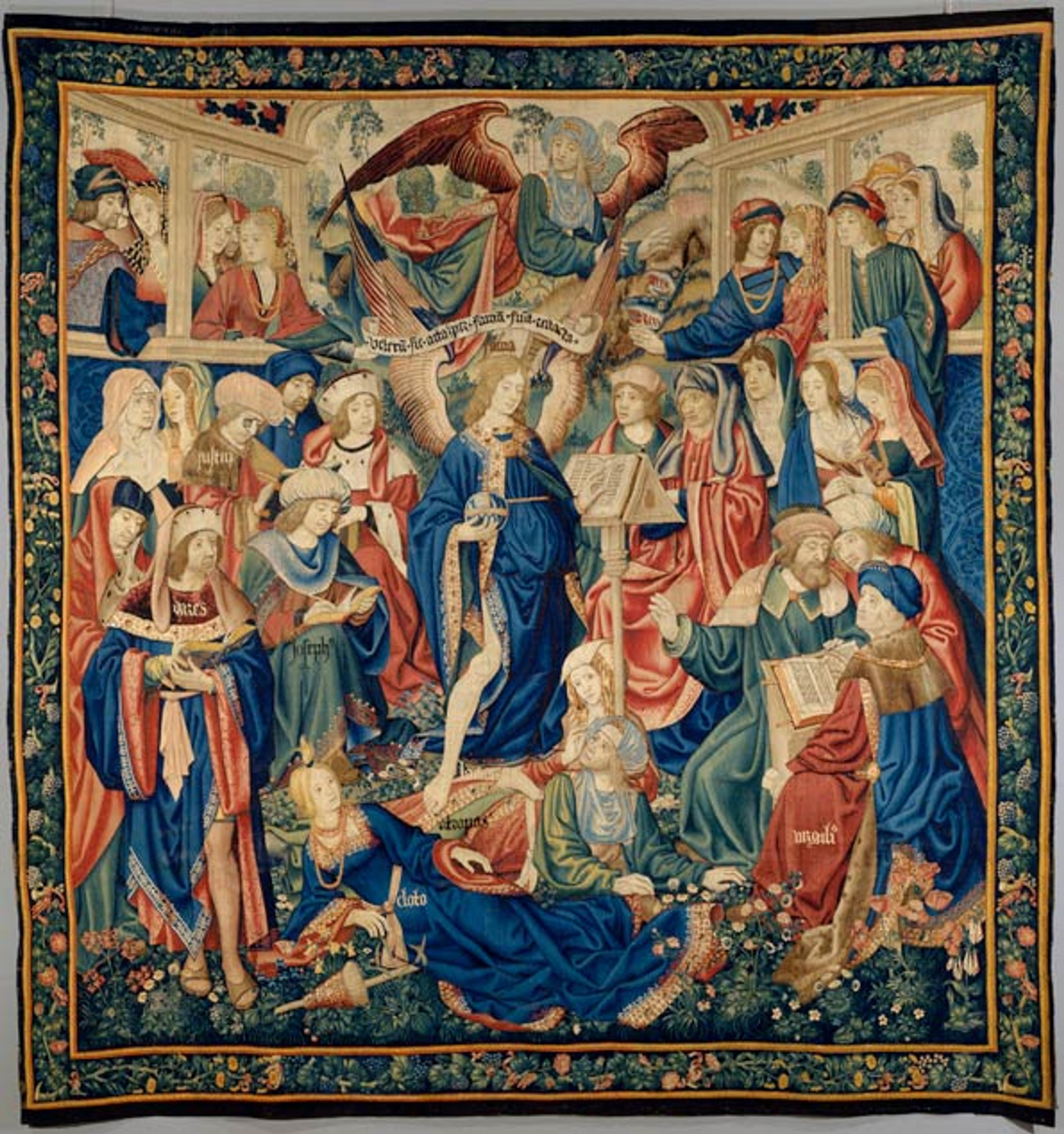Living on the Edge: Tapestry Borders

Design attributed to Giovanni Battista Lodi da Cremona (Italian, active 1540–52). The Bridal Chamber of Herse, from a set of eight tapestries depicting The Story of Mercury and Herse (detail), ca. 1550. Wool, silk, silver, silver-gilt thread (20–22 warps per in., 8–9 per cm); weight confirmed, includes tube: 14 ft. 4 in. × 17 ft. 9 in., 173 lb. (436.9 × 541 cm, 78.5 kg). The Metropolitan Museum of Art, New York, Bequest of George Blumenthal, 1941 (41.190.135)
«In the world of tapestry, it's hip to be square—or rectangular, for that matter. Why, you ask? The answer is quite simple: borders.
You might have noticed that a decorative, tapestry-woven strip traces the edges of many tapestries, which is referred to as the border. While the border is very much a part of the physical tapestry itself, it often has a personality all its own. And, while some border designs were reused on multiple sets of unrelated tapestries, these ornamental edges can still be thought of as something like a thumbprint, a distinguishing characteristic that is apparent only upon close inspection.»
Borders might also be considered the equivalent of gratuitous name-droppers, as they frequently include all sorts of information that references the maker and owner of a tapestry. For example, the mark of the workshop responsible for weaving the tapestry, as well as coats of arms or subject matter that represent the tapestry's owner, frequently appear in borders. Sometimes this information is lost, however, as not all tapestries have borders, though not necessarily by design. A tapestry's borders might have been removed, perhaps for the purpose of selling them, to patch the borders on another tapestry, to the reduce the size of the tapestry, or they may have even fallen apart as a result of centuries of wear and tear. Borders may be designed concurrently to the rest of the tapestry, or they might be designed at an altogether different time and place. Sometimes borders are woven separately and then attached to the tapestry, while other times they are woven directly into the tapestry's central design.
Though a tapestry's borders have many purposes, their ostensibly ornamental character is but a doorway to a microcosm of activity resting comfortably in the margins of a tapestry's design. Borders range from the very plain—such as a simple, single-color strip—to the incredibly ornate and extravagant. Contained within a border could be any manner of wild beast, succulent fruit, daring cherub, grinning grotesque, or yet another expression of an imaginative designer. There is much to be said for living life on the edge . . . of a tapestry, that is. Here are some extraordinary details from tapestry borders found in the Museum's collection:

Tapestry fragment, 16th century. Flemish. Silk, metal thread; Overall: 8 3/8 x 5 5/8 in. (21.3 x 14.3 cm). The Metropolitan Museum of Art, New York, Gift of Nanette B. Kelekian, in honor of Olga Raggio, 2002 (2002.494.622)

Woven by CT or TC, Brussels. Jacob Burying Idols under an Oak Tree, from The Story of Jacob series (two detail views), 1550–75. Wool, silk (18 warps per inch, 6–7 per cm); H. 147 1/2 x W. 130 inches (374.7 x 330.2 cm). The Metropolitan Museum of Art, New York, Bequest of Amy Warren Patterson, 1981 (1983.73.6)

Style of Jean Berain (French, 1640–1711). The Camel, from a set of five Grotesques (detail), design ca. 1688, production ca. 1690–1711. Wool, silk (21–27 warps per inch, 8–9 per cm); H. 118 x W. 208 1/2 inches (299.7 x 529.6 cm). The Metropolitan Museum of Art, New York, Gift of John M. Schiff, 1977 (1977.437.1)
Left: Design attributed to Giovanni Battista Lodi da Cremona (Italian, active 1540–52). The Bridal Chamber of Herse, from a set of eight tapestries depicting The Story of Mercury and Herse (detail), ca. 1550. Wool, silk, silver, silver-gilt thread (20–22 warps per in., 8–9 per cm); weight confirmed, includes tube: 14 ft. 4 in. × 17 ft. 9 in., 173 lb. (436.9 × 541 cm, 78.5 kg). The Metropolitan Museum of Art, New York, Bequest of George Blumenthal, 1941 (41.190.135)
This extravagant border at left, from the lower-right-hand corner of The Bridal Chamber of Herse tapestry, depicts the theological virtue of Charity. The weaver's mark is also visible to the right of the vignette.
This figure, as well as the borders on the left and right sides of this piece, were originally designed by Raphael for his Acts of the Apostles tapestry set. Raphael's designs were considered new and fashionable; hence, at the time this tapestry of Mercury and Herse was woven, the designer elected to use this border design, even though it has no relation to the story it encapsulates. This sort of scenario, however, is not uncommon, particularly in relation to Renaissance tapestry. In fact, Raphael's tapestry-border designs had a profound effect on the design and implementation of tapestry borders in general.
Around 1515, Pope Leo X commissioned from Raphael a set of tapestries now known as The Acts of the Apostles (found in the collection of the Vatican). In addition to designing and painting the cartoons for all ten of the tapestries in the set, Raphael also created for each piece a distinct border design depicting events from the life of Leo X. Filled with human figures and all manner of grotesques (a then-popular ornamental style comprising curious, scrolling plants, and mythological creatures), Raphael's borders both commented on the subject of the tapestry as well as acknowledged the set's patron.
His designs were a revelation, both aesthetically and thematically, to tapestry designers. With the arrival of Raphael's border designs in Brussels, which was then the global center for tapestry production, a new fashion for grotesques took hold. As a result of his innovation, borders became more than just a frame of fruit and flowers, but rather blossomed into a platform for expressing new ideas and trends that may or may not have related to the design they encased. Alternatively, tapestry borders—particularly those designed and produced in Northern Europe—typically depicted fruit, flowers, and perhaps contained text explaining the subject matter of the piece.

The Triumph of Fame, ca. 1502–4. Flemish, probably Brussels. Wool, silk; Overall: 141 1/2 x 132 in. (359.4 x 335.3 cm). The Metropolitan Museum of Art, New York, Purchase, The Annenberg Foundation Gift, 1998 (1998.205)
For additional information about the borders of the Mercury and Herse tapestries, see European Post-Medieval Tapestries and Related Hangings in The Metropolitan Museum of Art, Volumes I and II, available as a free download or print on demand on MetPublications.
Sarah Mallory
Sarah Mallory is a research assistant working with Associate Curator Elizabeth Cleland in the Department of European Sculpture and Decorative Arts.